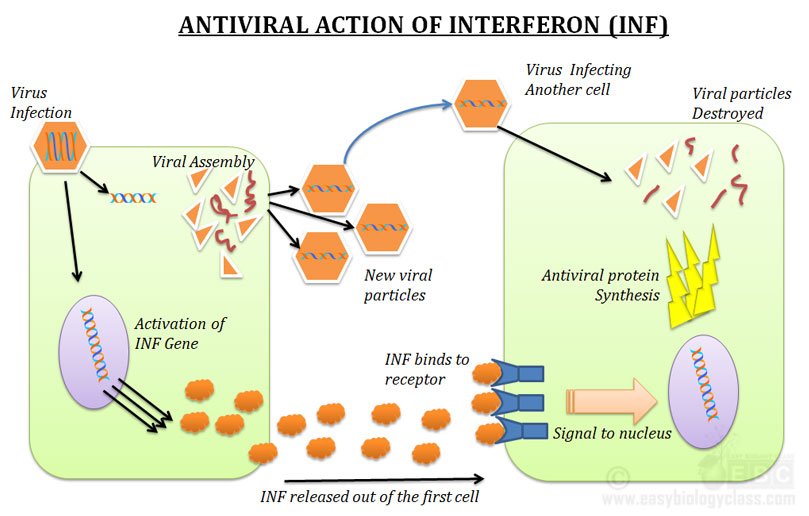Interferons are Glycoproteins with Antiviral Properties
Interferons or INFs are low molecular weight glyco-proteins produced by certain eukaryotic cells in response to viral infections. They are cytokines with indirect or non-specific antiviral activities. Interferons stimulate the production of antiviral proteins in the cells which inhibit the synthesis of viral RNA and proteins.
Interferons cannot directly inhibit the viral entry into the host cell. However, they can inhibit the replication of viral gene and the assembly of viral particles and thereby they limit the viral infection.
Interferons also regulate the growth, differentiation and functions of different types of immune cells in animals. Several classes of interferons are recognized in eukaryotes such as INFα, INFβ and INFγ. INFα and INFβ are produced by virus infected fibroblasts. Virus infected leukocytes, antigen stimulated T cells and natural killer cells can produce INFγ.
Interferon Production is Triggered by Viral Infection
The synthesis and release of interferons form a cell is induced by the viral particles. The intact viral particles and even the presence of double stranded viral RNA (dsRNA) in the cell can evoke the production of interferons. Specific interferons are recognized by receptors present on the plasma membrane.
Once a cell receives the stimuli, the interferon proteins are synthesized and they are released out of the cell. Since they are secreted to the exterior of the cells, they can bind to its plasma membrane receptors. The secreted interferon molecules then bound to the ganglioside receptors on the plasma membrane of another cell (nearby or located far away from the secretion).

Interferon inhibits Viral Replication by inhibiting Transcription Initiation Factor eIF2
The binding of interferons to its receptors triggers the production of many enzymes that render the cell’s resistance to the viral infection. The two important antiviral enzymes whose production is triggered by the INF are Oligo(A) Synthetase and Protein Kinase R (PKR). When an INF-stimulated cell is infected by the viral particle, the viral protein synthesis is inhibited by an active endoribonuclease enzyme by degrading the viral RNA. The activated protein kinase enzyme, whose production is triggered by the INF, phosphorylates the initiation factor eIF2. The eIF2 initiation factor is very essential for viral protein synthesis.
Functions of Interferons in the Cell
Ø Have indirect antiviral properties
Ø Restrict the replication and assembly of viral particles
Ø Interferons can also activate T cells
Ø Can activate macrophages, neutrophils and natural killer cells
Ø Have anti-proliferative effects on cell division
Ø Increase the expression of MHC class I and Class II molecules in various cells
Ø Enhance the phagocytic properties of macrophages
Ø Increase the antigen presenting capacity of antigen presenting cells
Clinical Uses of Interferons
Ø IFNα is used in the treat of hepatitis B and C infections (HBV and HCV).
Ø IFNβ is used in the treatment of multiple sclerosis (MS) and autoimmune disorders.
Ø Interferons have antitumor properties
Ø Interferon therapy is used in combination with chemotherapy in the treatment of some cancers.
Interferons are classified into Type I and Type II
Interferons are classified into three classes based on their type of receptors and they are named as Type I, and Type II Interferons.
Type I Interferons (INFα and INFβ)
All the type I interferons have a common ancestral gene in eukaryotes. The synthesis of type I interferons are triggered by viral or bacterial infections. In eukaryotes five sub-categories of Type I interferons are recognized, they are INFα, INFβ, IFNε, IFNκ and IFNω. Among these the INFα and INFβ are the most important. At least 12 different types of INFα are produced by infected leukocytes and epithelial cells in response to viral infections.
INFβ are produced by fibroblasts and epithelial cells during viral or bacterial infections. Important pro-inflammatory cytokines such as Interleukin 1 (IL-1) and Tumor Necrosis Factor-α (TNFα) are the potent induces of INFα/β in the cells. Type I interferons have a significant role in the innate immune system against viral infections. Both INFα and INFβ can inhibit protein synthesis in virus infected cells by preventing translation and DNA replication. The type I interferons also activate natural killer cells and increase the expression of MHC Class I molecules.
Type II Interferon (INFγ)
Interferon-γ is the type II interferon. They are produced by the T-helper type-1 cells and Natural Killer cells. INFγ stimulate the expression of Class II MHC molecules in different types of cells. Expression of MHC Class II molecules enhances the phagocytic properties of these cells. It also increases the antigen presenting capacity of antigen presenting cells. Expression of INFγ is very essential for the proper functioning of macrophages. The INFγ activated macrophages can only kill invading bacteria as other parasites by the production of reactive oxygen molecules. Apart from this INFα inhibits the proliferation of T-helper type-2 cells.
Key Questions
1. What are interferons?
2. What are the functions of interferons?
3. Interferons possess ‘indirect’ antiviral properties. Justify
4. How interferons restrict the replication and assembly of viral particles?
5. Write a short note on classification of Interferons.
6. Differentiate Type I and Type II Interferons.
7. What are the functions of Type I Interferons?
8. What are the functions of Type II Interferons?
9. Differentiate INFα, INFβ, INFγ.
Learn more: Difference between Type I and Type II Interferons
